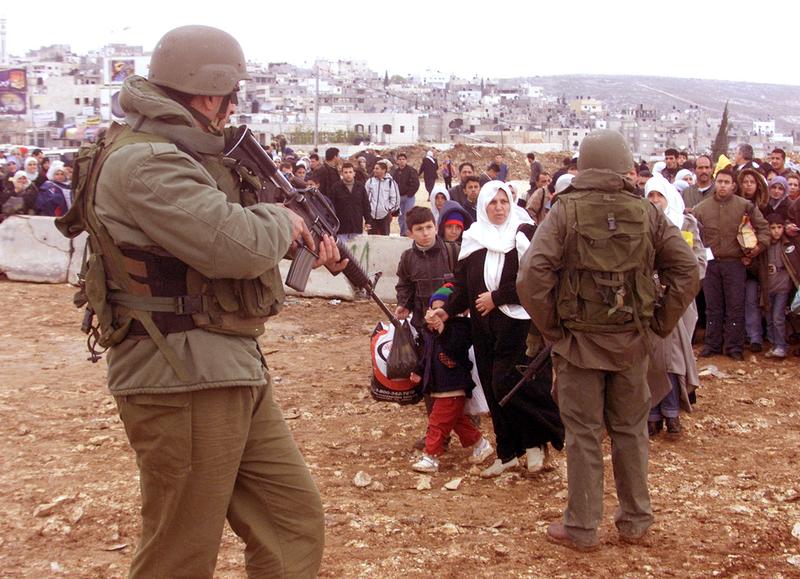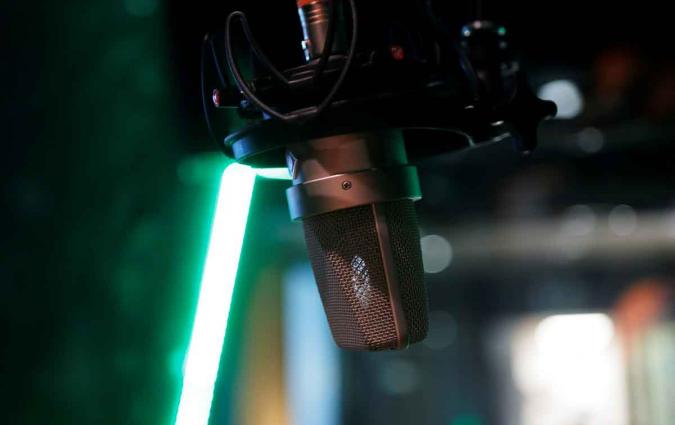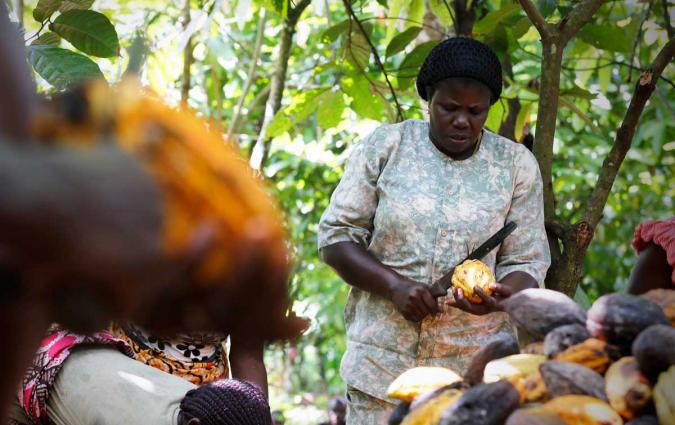In this piece
Constructive correspondence: a new approach to foreign assignments

A Ramallah checkpoint in 2002. Credit: Reuters
In this piece
Striking a balance | What’s in a name? | A fresh addition to the correspondence toolkit | What does constructive correspondence look like? | What are the barriers? | The (constructive) revolution will be televised | Reading listThe sound of automatic rifles is not that loud: more like cracks than explosions. However, I am still terrified as I position myself among cars waiting at an Israeli army checkpoint on a road connecting Jerusalem and Ramallah.
The bullets pass overhead. The entire incident lasts mere moments, and then there is silence. Just as quickly as the gunfire began, everyone returns to a semblance of normalcy.
This time, the bullets have not struck anyone. I am informed that they are probably warning shots fired due to someone's reluctance to comply with the soldiers' orders. With the young Israeli guards feeling back in control, the Palestinians return to their places in line, ready to pass through the muddy checkpoint.
For them, it's just another typical day in the West Bank. The year is 2002, and I am both terrified and fascinated as I witness this unfolding scene during the second intifada. This is the story I intend to share with my readers in Denmark about the ongoing conflict: to illustrate its impact on individuals from both sides. The drama, the tragedy, the terror that occurs when political violence becomes a part of everyday life.
There are stories of hope and solutions too, but these are much harder to get published.
My experience in the Middle East offers an extreme example of why the conversation I want to initiate here requires nuance. Reporting on violent conflicts and clashes cannot and should not be trivialised or normalised. Nevertheless, I believe that constructive solutions journalism has its place in a correspondent's toolkit. It's crucial to tell the complete truth, not just the tragic aspect.
Jeffrey Gettleman, former East Africa Bureau Chief for the New York Times, encapsulated it well: "I want to show people that Africa is not all about AK47s and malnourished children with visible ribcages."
Striking a balance
The discussion I hope to provoke revolves around a central question: How can correspondents strike a balance between reporting calamity and hope when covering global events?
I’ve been strong advocate, practitioner, and student of constructive journalism over the past decade, including a year spent at The Constructive Institute at Aarhus University in 2017. Drawing from my experiences reporting in both the Middle East and post-civil war Yugoslavia in 2001, I now stand on the brink of a new assignment: starting September 2023, I will become Politiken's US correspondent based in Washington DC. When applying for this position, I boldly pledged to bring my constructive journalism experience to my work in the United States.
This won't be an easy undertaking in today's US landscape. "Good luck with that," as my American co-fellow at the Reuters Institute, Ayen Deng Bior Patinkin put it.
What’s in a name?
Focusing on the constructive solution approach for correspondents, rather than debating whether or why to adopt it, is my chosen path. While definitions may vary slightly between regions, both "Constructive Journalism" (predominantly used in Europe) and "Solutions Journalism" (more common in the US) aim to shed light on how people respond to social issues.
For the purpose of inclusivity, I'll refer to this approach as a constructive solution approach, encompassing all journalistic practices that delve beyond just the problems at hand.
Correspondents I've spoken with are more interested in challenging the "if it bleeds, it leads" mentality than dwelling on semantics or empirical research. They understand that journalistic work in the field is flexible, shaped by the given conditions. Not every story will neatly adhere to the strictest definitions of the Constructive or Solutions approach.
A fresh addition to the correspondence toolkit
Africa correspondent Søren Bendixen has had a change in perspective. “I can’t sell bad news. If I don’t find the constructive approach, it is very difficult for me to argue for a story,” he told me.
“When the request for more constructive news was promoted by [Denmark’s biggest public service radio operation] DR back in 2008, I was annoyed. I had just returned from Congo and there was misery all over the place. But today, 15 years later, I’m in a different place.
“When I am doing the daily news and people, for example, start shooting at each other in Sudan, I can’t take a constructive approach. But when I plan to go out on reportage it will be with a constructive aim. I meet those who try to do something different. It is a big part of what I see in Africa. I see a lot of misery, but I also see people who are trying to make a positive change,” he said.
“I don’t need to turn my perspective upside down or try to sell something I can’t vouch for. But the two aspects are a good combination,” he said, adding that pitching constructive solution stories is now a better path to getting resources assigned.
“If I suggest a story without a constructive element my editors are not likely to approve. I don’t need to do a detailed budget for every story, but I need to be rather precise about what I imagine the outcome will be. These are expensive productions and I don’t have unlimited access to [fill DR outlets airtime] in a week,” he said.
As I conversed with correspondents Søren Bendixen, Simi Jan, Matilde Kimer, Jesper Steinmetz, and Jørgen Ullerup, it became apparent that they all have embraced constructive journalism's essence. They seek to challenge stereotypes, defy prejudice, and encourage empathy for individuals, regardless of their geographical location. (Find their full accounts in the PDF below.)
What does constructive correspondence look like?
We’ve established by now that I am a fan of constructive solutions, but I was still surprised to find that every correspondent I spoke to had embraced the notion that stories needn’t just bleed to lead – those that ignite hope can also be in scope.
When I asked the correspondents for evidence that they’d implemented the constructive solution approach, they all had examples.
When Bendixen covered extreme drought in Kenya, he interviewed a couple producing and selling milk from camels. The drought had made it near impossible to provide enough water for cow herds, so they had found a more sustainable approach. The story was aired in a primetime slot.
Steinmetz covered a firm in Alabama that produced bulletproof classrooms to be ready for school shootings. “Seen from a Danish perspective it is crazy to introduce such classrooms instead of reducing the number of guns. But it also tells a story about America. We know there will be more shootings and school kids who are in danger of being killed. So, what do we do to prevent this from happening?”
Jan often looks for constructive angles too, even amid misery. For example, when reporting on the Syrian refugee crisis, “I portrayed a small Turkish organisation who collect money and send bread to refugees on both sides of the border.”
She had examples from Afghanistan, too: “When Kabul fell [in 2022] teachers started to help girls go to secret and forbidden schools. I talk to the teachers who said we need to do something to help our daughters and our students. We can’t just give up because Taliban has taken Afghanistan. Is it constructive? Hell, yeah. It is important so the viewers don’t think: they are all victims.”
Many of her colleagues echo that sentiment: they want to tell stories that challenge stereotypes and prejudice, and give their audience a chance to empathise with humans wherever they report from.
Kimer said constructive stories are the most satisfying to work on. She has won several prizes for her work, including one for coverage of a wedding in the midst of bombing in Kharkiv, Ukraine.
That story was not strictly constructive solution journalism, but it is a story about hope and the will to keep living in wartime. Or, as the bride puts it: “Russia should know that they can’t kill love.”
What are the barriers?
The most obvious one, as Kimer put it: “To be honest, these are the stories you can do after you have delivered what you need to do [straight news]. Is it good, is it bad? It’s the reality. You are seldom allowed to do research for a week for a constructive story,” she said.
So, while editors at DR want more focus on constructive news, it is often up to the correspondent to find the time to do it.
Several of her colleagues mentioned the same obstacle: when news is breaking, there isn’t always time to find the constructive angle.
“I’ve covered many school shootings unfortunately,” said US correspondent Steinmetz. “Often we go there and people are gathering around the school or the supermarket. It’s relatively easy to find someone who wants to talk [but] in these situations, there is no time to do constructive angles. It comes later.”
Jan agreed, adding: “On the first and the second day it is the actual breaking news. And then after a few days there is an openness towards other angles.”
Ullerup said the pressure on correspondents is another important barrier to doing features and constructive solution news. “When I started at Jyllands-Posten, we were 25 correspondents. Now we are around a handful left,” he said. That means a correspondent in Paris must be ready to pivot to news on topics in other parts of the world. “Every third story I do is still on Ukraine,” he said.
This leaves editors and management with a choice: if they want to give the audience more constructive solution stories and more nuanced coverage of the world, they should rely to a higher degree on wires for breaking news and let the correspondents focus on doing features.
The (constructive) revolution will be televised
Returning to my starting point and the Israeli checkpoint where I hit the ground more than 20 years ago, it is clear that things have begun to change.
For decades, we told the same stories of despair, terror, war, and tragedy from the Middle East. Don’t just take my word for it; Steffen Jensen, who recently retired after 35 years of reporting from the Middle East for TV2, told Danish magazine, Journalisten: “[I said to] my boss that for over 30 years I have been covering the Middle East according to the same old, distorted news criteria that force us to go wrong. I think this is a problem, because I have helped increase fear and lack of understanding of what is happening in a region where a lot of different things are going on. I would like to do something about these things. My boss smiled and said, ‘Yes, that sounds really interesting, but where do you intend to publish it?’ By implication: not on the national TV channels.”
But the correspondents I spoke to suggest a growing awareness of the need for telling a broader story – the whole story. Not just in the Middle East, but around the world.
Correspondents who want to adopt this route will have an easier time than Jensen and me: for starters, editors are showing an appetite for constructive solution angles. Second, the audience is rewarding these narratives with attention.
In the end, the journey to introduce constructive solutions into journalism isn't without obstacles, but it's a journey worth taking. As correspondents increasingly focus on providing stories that encompass both challenges and solutions, a positive change in journalism is taking root.
This transformation, guided by a more nuanced and balanced approach, ensures that the narrative isn't solely defined by conflict, but by the resilience and innovation of individuals across the world.
Reading list
- Peter Bro, (2023), Constructive Journalism: Precedents, Principles, and Practices (1st ed.). Routledge. https://doi.org/10.4324/9781003403098
- Lisbeth Hermans & Tineke Prins (2020), Interest matters: The effects of constructive news reporting on Millennials’ emotions and engagement.
Journalism, 23(5), 1064–1081 - Karen Elizabeth & Kyser Lough (2019), Toward a clearer conceptualization and operationalization of solutions journalism. Journalism, 22(6), 1558–1573.
- Karen Elizabeth & Kyser Lough (2021), Transitioning to Solutions Journalism:
One Newsroom's Shift to Solutions-focused Reporting. Journalism Studies,
22:2, 193-208 - Jacob L. Nelson & Nicole S. Dahmen, (2023), Appealing to News Audiences or News Funders?’ An Empirical Analysis of the Solutions Journalism Network’s Revenue Project, Journalism Practice.
- Elia Powers & Alex Curry (2019), No quick fix: How Journalists Assess the Impact and Define the Boundaries of Solutions Journalism. Journalism Studies, 20:15, 2237-2257
- Benjamin Toff & Rasmus Kleis Nielsen, (2022), How news feels: Anticipated Anxiety as a Factor in News Avoidance and Barrier to Political Engagement. Political Communication, 39:6, 697-714
- Simi Jan (2022), Kære Kabul, People’s Press.



